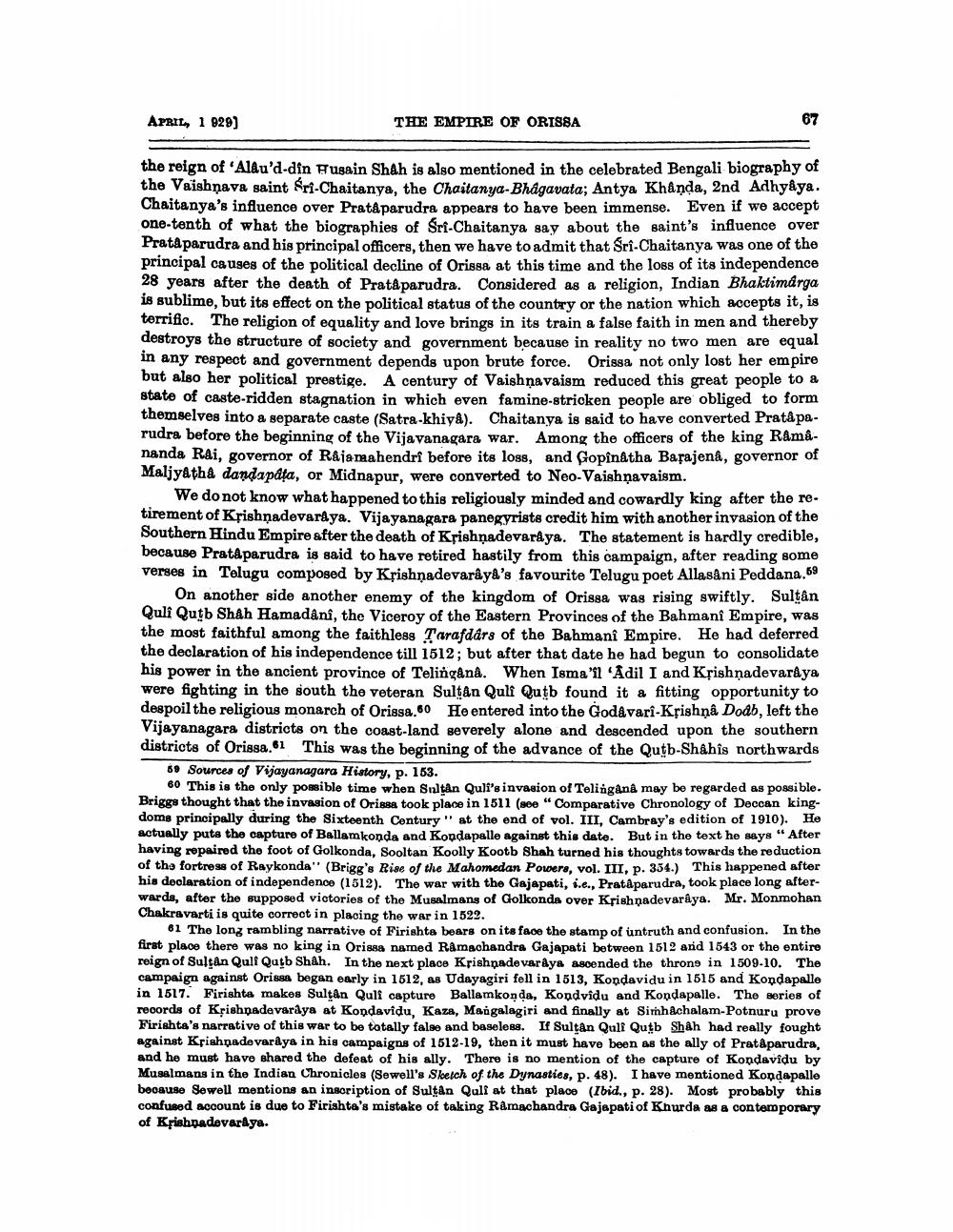________________
APRIL, 1 029)
THE EMPIRE OF ORISSA
the reign of Alau'd-din Fugain Shah is also mentioned in the celebrated Bengali biography of the Vaishnava saint Sri Chaitanya, the Chaitanya-Bhagavata; Antya Khanda, 2nd Adhyâya. Chaitanya's influence over Pratáparudra appears to have been immense. Even if we accept one-tenth of what the biographies of Sri Chaitanya say about the saint's influence over Prataparudra and his principal officers, then we have to admit that Sri Chaitanya was one of the principal ca uges of the political decline of Orissa at this time and the loss of its independence 28 years after the death of Prat& parudra. Considered as a religion, Indian Bhaktimdrga is sublime, but its effect on the political status of the country or the nation which accepts it, 18 terrific. The religion of equality and love brings in its train a false faith in men and thereby destroys the structure of society and government because in reality no two men are equal in any respect and government depends upon brute force. Orissa not only lost her empire but also her political prestige. A century of Vaishnavaism reduced this great people to & state of caste-ridden stagnation in which even famine-stricken people are obliged to form themselves into a separate caste (Satra-khiya). Chaitanya is said to have converted Prataparudra before the beginning of the Vijavanagara war. Among the officers of the king Ramananda Rai, governor of Rajamahendri before its loss, and Gopinatha Barajena, governor of Maljyatha dandapata, or Midnapur, were converted to Neo-Vaishnavaism.
We do not know what happened to this religiously minded and cowardly king after the retirement of Krishnadevaraya. Vijayanagara panegyrists credit him with another invasion of the Southern Hindu Empire after the death of Krishnadevaraya. The statement is hardly credible, because PratAparudra is said to have retired hastily from this campaign, after reading some verses in Telugu composed by Krishnadevaraya's favourite Telugu poet Allasâni Peddana.69
On another side another enemy of the kingdom of Orissa was rising swiftly. Sultan Quli Qutb Shah Hamadani, the Viceroy of the Eastern Provinces of the Bahmani Empire, was the most faithful among the faithless Tarafdars of the Bahmani Empire. He had deferred the declaration of his independence till 1512; but after that date he had begun to consolidate his power in the ancient province of Telingana. When Isma'll 'Adil I and Krishnadevaraya were fighting in the south the veteran Sultan Quli Qutb found it a fitting opportunity to despoil the religious monarch of Orissa.60 He entered into the Godavari-Krishna Dodb, left the Vijayanagara districts on the coast-land severely alone and descended upon the southern districts of Orissa.61 This was the beginning of the advance of the Qutb-Shahis northwards
69 Sources of Vijayanagara History, p. 163.
60 This is the only possible time when Sultan Quli's invasion of Telingana may be regarded as possible. Briggs thought that the invasion of Orissa took place in 1511 (800" Comparative Chronology of Deccan kingdoma principally during the Sixteenth Contury" at the end of vol. III, Cambray's edition of 1910). He actually puts the capture of Ballamkonda and Kondapalle against this date. But in the text he says "After having repaired the foot of Golkonda, Sooltan Koolly Kootb Shah turned his thoughts towards the reduction of the fortress of Raykonda'' (Brigg's Rise of the Mahomedan Powers, vol. III, p. 354.) This happened after his declaration of independence (1512). The war with the Gajapati, i.e., Prataparudra, took place long afterwards, after the supposed victories of the Musalmans of Golkonda over Krishnadevaraya. Mr. Monmohan Chakravarti is quite correct in placing the war in 1522.
61 The long rambling narrative of Firishta bears on its face the stamp of untruth and confusion. In the first place there was no king in Orissa named Ramachandra Gajapati between 1512 and 1543 or the entire reign of Sultan Quli Qutb Shah. In the next place Krishnade varêya ascended the throne in 1509.10. The campaign against Orissa began early in 1512, as Udayagiri fell in 1513, Kondavidu in 1615 and Kondapallo in 1517. Firishta makos Sultan Qull capture Ballamkonda, Kondvidu and Kondapalle. The series of records of Krishnadevaraya at Kondavidu, Kaza, Mangalagiri and finally at Sirnh&chalam-Potnuru prove Firishta's narrative of this war to be totally false and baseless. If Sultan Quli Qutb Shah had really fought against Krishnadevaraya in his campaigns of 1512-19, then it must have been as the ally of Prataparudra, and he must have shared the defeat of his ally. There is no mention of the capture of Kondavidu by Musalmans in the Indian Chronicles (Sewell's Sketch of the Dynasties, p. 48). I have mentioned Kondapallo because Sewell mentione an inscription of Sultan Quli at that place (Ibid., p. 28). Most probably this confused account is due to Firishta's mistake of taking Ramachandra Gajapati of Khurda as a contemporary of Krishnadevaraya.




